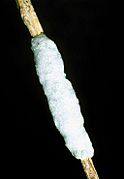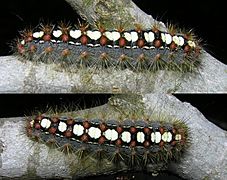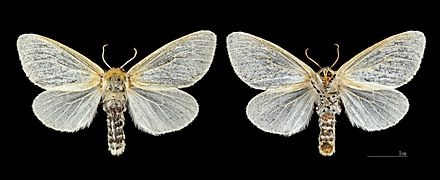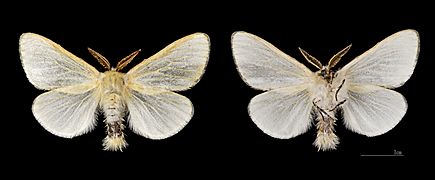White satin moth facts for kids
Quick facts for kids White satin moth |
|
|---|---|
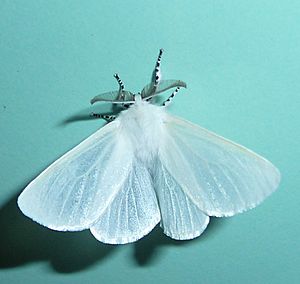 |
|
| Scientific classification |
The white satin moth (Leucoma salicis), also called the satin moth, is a type of moth from the Erebidae family. It was first described by Carl Linnaeus in 1758. You can find this moth in Europe, including the British Isles, and across Asia to Japan. It was also brought to North America in the 1920s.
Contents
What Does the White Satin Moth Look Like?
This moth has a wingspan of about 37 to 50 millimeters (about 1.5 to 2 inches). Its wings are usually white. Sometimes, the edges of the wings can be a bit yellowish or even dark in males. The moth's head and the feathery parts of its antennae are often dark. Its legs have wide black rings.
Moths from East Asia, like Leucoma candida, are often a purer, shiny white. They also have thicker wings and are generally smaller. The white satin moth lives in most parts of Eurasia, south of the Polar Circle, but not in far northeastern Siberia.
Life Cycle and Habitat
White satin moths lay their eggs on tree trunks. They place them in groups and cover them with a material that looks like paper.
Caterpillar Stage
The young moths, called larvae or caterpillars, are black. They have a line of light spots down their back. They also have a yellow line along their sides. Segments four and five of their bodies each have two fleshy, pointed bumps.
These caterpillars love to eat the leaves of willow and poplar trees.
Pupa Stage
When a caterpillar is ready to change, it forms a loose cocoon. This cocoon is usually found between leaves. Inside, the pupa is shiny black with white spots. It also has yellow tufts of hair.
Adult Moth Stage
The adult moths appear in June, July, and August. Male moths start flying before it gets dark in the evening. They often fly around poplar and willow trees near country roads, looking like snowflakes.
You can find white satin moths in places that are a bit shady and damp. This includes forest edges and hedges where their favorite food plants grow. They also live in avenues, parks, and gardens. They are common, but usually you only see a few at a time. In the past, there were reports of "population explosions" where many moths appeared at once.


